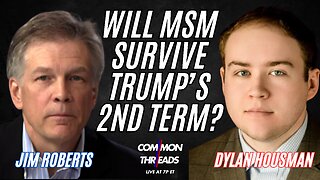Premium Only Content

An Introduction to Servant Leadership
website: https://leadershipexcellencenow.com
Contact Greg: coach@leadershipexcellencenow.com
What You Need to Know About Leadership: https://youtu.be/JksBvW7lm6E
Autocratic Leadership is Toxic: https://youtu.be/WSdOwTGATGQ
I will have a number of videos on this topic but the first thing I want to do in this video is explain some of the similar tasks that both autocratic leaders and servant leaders share. They both face the same needs, problems, opportunities and pressures. The difference is how they approach or face these challenges. One's motives, perspectives and attitudes are what separates a traditional autocratic leader with a servant leader. Let’s begin…
One of the myths of servant leadership is that it is somehow soft, or not clearly definable. Yes, it may appear this way… but only if you have been conditioned by your culture to think in terms of dogmatic control, and knee-jerk decision-making. The truth is that autocratic leaders and servant leaders face most of the same difficulties but they approach them in vastly different ways. Here are some of the responsibilities they share.
Vision and Mission focused – The best leaders have the ability to create an inspiring mental picture of a better, preferred future. They offer a visionary plan of where you… or the organization… will be in 5-years, 10-years, or 25-years. Great leaders paint the future in such rich vivid images that co-workers can virtually imagine it, and aspire to be part of it. Leaders also remind everyone to keep their focus and attention on the company’s stated mission.
Values - Authentic leaders strive to support a values-based climate in the organization. These values impact every aspect of a company – how it does business, how it makes decisions, how it treats its employees and customers. Some key qualities include a commitment to integrity, mutual respect, collaboration and teamwork.
Adaptability - Leaders know that routines, plans, and schedules can change at any time. A resilient leader, aims for a flexible approach that allows the organization to “pivot” as necessary, especially in times of new opportunity or threat.
Focus - Intensity helps the leader to handle possible distractions while achieving their major objectives. By giving their attention to the most important projects and needs, leaders complete their largest goals while managing their limited time and resources.
Stability – Effective leaders are tasked with driving needed change, yet…they also need a strong sense of stability. Taking a steady, reliable approach can allow you to keep your strategy, team or company on track. Establishing regular routines and telling your team what to expect… allows you, and your staff members to maintain energy and focus, even as you strive for constant progress.
I will explain some of the differences in perspective using just two examples.
Example #1 Shareholders vs Stakeholders
Autocratic leaders are primarily concerned with themselves, and the organizations shareholders. These are individuals who hold a “share” or ownership of the company. These leaders are especially motivated to accommodate the largest shareholders who yield some power, or could potentially challenge them, or could initiate a change in ownership in the organization. With an autocratic mindset… it’s the autocrat’s desires, and those of the shareholders that is always first and foremost. This has a tendency to motivate the leader to focus on short-term profit and loss.
In contrast to this… servant leaders are primarily concerned with the organizational mission, and its stakeholders. These are the internal and external partners who have a stake or vested interest in the long-term success of the organization. This includes not only the external shareholders, but also its workforce who support their families by their employment, vendors to sell products to the company, customers who expect quality products or services from the company. The servant leader balances the strategy and decisions they make to serve the needs of those who have a share in the organization’s long-term success and future. This has a tendency to motivate the leader to focus on long-term achievements and profit.
The 2nd example between an autocratic leader and servant leader is the positive organizational culture created by a dedication to servant leadership principles.
These leaders aspire to create and maintain a culture that not only works effectively, but is also fun-loving, creatively driven and is “work” family, and community-oriented. It is based on the “core value” that if you take care of people, put people first… the profit will take care of itself. It promotes the idea of “people caring for people” and this encourages everyone to honor their commitments and keep their promises and obligations. In our next video on the topic of servant leadership we will define more distinctly what it is, and the positive results it produces.
-
 44:34
44:34
Kimberly Guilfoyle
4 hours agoCountdown to Inauguration Day, Plus California in Crisis, Live with Joel Pollack & Roger Stone | Ep. 189
69.2K22 -
 1:32:41
1:32:41
Redacted News
3 hours agoBiden's 'SNEAKY' plot to slow down Trump REVEALED | Redacted w Clayton Morris
83K108 -
 56:32
56:32
Candace Show Podcast
3 hours agoOH SNAP! Justin Baldoni Is Now Suing Blake Lively and Ryan Reynolds PERSONALLY | Candace Ep 134
60.6K64 -
 UPCOMING
UPCOMING
Havoc
38 minutes agoHell on Earth | Stuck Off the Realness Ep. 24
-
 LIVE
LIVE
Tundra Tactical
1 hour agoATF Violates Court Order to ATTACK Americans.
52 watching -
 LIVE
LIVE
Common Threads
1 hour agoLIVE DEBATE: Will Mainstream Media Survive a 2nd Trump Term?
156 watching -
 LIVE
LIVE
Quite Frankly
5 hours ago"Biden's Farewell, Dreams For Sale, Spy Hunting, and Open Lines" 1/16/25
312 watching -
 LIVE
LIVE
Sarah Westall
49 minutes agoCalifornia puts Children 2nd to Big Pharma Profits, Chemically Castrating Boy w/out Dad’s Consent
61 watching -
 LIVE
LIVE
theDaily302
10 hours agoThe Daily 302- Craig "Sawman" Sawyer
40 watching -
 11:45
11:45
Reforge Gaming
9 hours agoHalo on PS5 - Nothing is Sacred
4.31K1